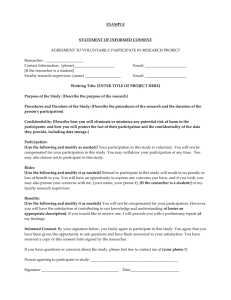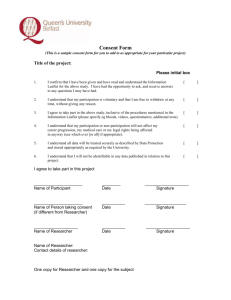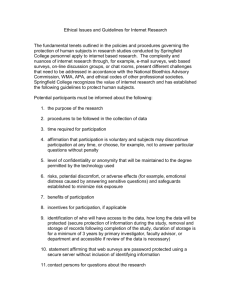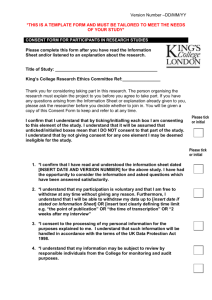Protocol Description Form - OU IRB
advertisement
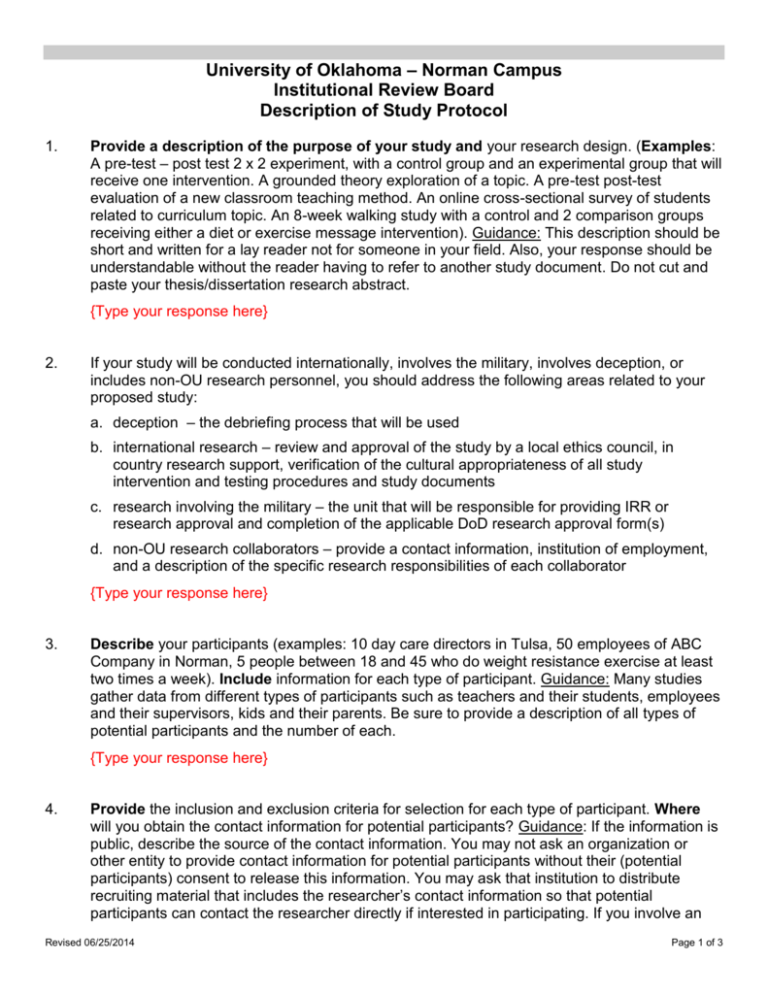
University of Oklahoma – Norman Campus
Institutional Review Board
Description of Study Protocol
1.
Provide a description of the purpose of your study and your research design. (Examples:
A pre-test – post test 2 x 2 experiment, with a control group and an experimental group that will
receive one intervention. A grounded theory exploration of a topic. A pre-test post-test
evaluation of a new classroom teaching method. An online cross-sectional survey of students
related to curriculum topic. An 8-week walking study with a control and 2 comparison groups
receiving either a diet or exercise message intervention). Guidance: This description should be
short and written for a lay reader not for someone in your field. Also, your response should be
understandable without the reader having to refer to another study document. Do not cut and
paste your thesis/dissertation research abstract.
{Type your response here}
2.
If your study will be conducted internationally, involves the military, involves deception, or
includes non-OU research personnel, you should address the following areas related to your
proposed study:
a. deception – the debriefing process that will be used
b. international research – review and approval of the study by a local ethics council, in
country research support, verification of the cultural appropriateness of all study
intervention and testing procedures and study documents
c. research involving the military – the unit that will be responsible for providing IRR or
research approval and completion of the applicable DoD research approval form(s)
d. non-OU research collaborators – provide a contact information, institution of employment,
and a description of the specific research responsibilities of each collaborator
{Type your response here}
3.
Describe your participants (examples: 10 day care directors in Tulsa, 50 employees of ABC
Company in Norman, 5 people between 18 and 45 who do weight resistance exercise at least
two times a week). Include information for each type of participant. Guidance: Many studies
gather data from different types of participants such as teachers and their students, employees
and their supervisors, kids and their parents. Be sure to provide a description of all types of
potential participants and the number of each.
{Type your response here}
4.
Provide the inclusion and exclusion criteria for selection for each type of participant. Where
will you obtain the contact information for potential participants? Guidance: If the information is
public, describe the source of the contact information. You may not ask an organization or
other entity to provide contact information for potential participants without their (potential
participants) consent to release this information. You may ask that institution to distribute
recruiting material that includes the researcher’s contact information so that potential
participants can contact the researcher directly if interested in participating. If you involve an
Revised 06/25/2014
Page 1 of 3
institution or other entity in recruitment activities, upload a signed, site- support letter, on the
organization’s letterhead, that confirms that the signor has reviewed your research design and
is willing to assist you in participant recruitment. Please note that access to contact information
as a component of your job function DOES NOT automatically mean that you have access to
this information for research purposes. This permission must be provided by your employing
organization.
{Type your response here}
5.
Recruitment: Who will approach potential participants? What information are potential
participants given about the study? What safeguards are in place to minimize coercion? If the
researcher(s) is also the participants’ supervisor/instructor, how will you assure that the identity
of the research participants remains unknown to the researchers until after (1) the data have
been gathered and are de-identified or (2) the class grades have been assigned? Guidance: If
the participants are under the direct supervision of the researcher(s) (such as employees or
students of the researcher(s)), someone other than the researcher must conduct all
recruitment and identifiable data collection activities. Upload recruitment materials, such as
verbal or written scripts, email messages, postings to websites, flyers, and/or letters. If you
recruit participants who are not at OU, include this language: “The University of Oklahoma is
an Equal Opportunity Institution.” For OU mass email – you must have the proper
permission to use the email list and must include this language in your email message: “The
OU IRB has approved the content of this advertisement but the investigator is
responsible for securing authorization to distribute this message by mass email.”
{Type your response here}
6.
What identifying information will you collect? How long will you retain participant
contact/identifying information? How will you store this information during the study? How will
you dispose of contact information when the study is completed or when you no longer need
this information? Guidance: If you do not have permission to report the names of your
participants, then it is advisable to assign pseudonyms or study numbers to each participant as
soon as the data are collected to reduce the risk to participants if research files are
accidentally released. Participants can give you permission to release their identities or to
store identifiable research records in the Waiver of Elements of Confidentiality section of the
informed consent documents.
{Type your response here}
7.
Provide a step-by-step description of each of the tasks that participants will be asked to
perform during the study. Guidance: Tasks include the consent process, completion of data
collection instruments and any intervention or de-briefing activities.
For each study task, list each task sequentially in the order participants will complete it;
indicate the approximate time it will take to complete each task and the setting (such as, in a
classroom, in the participants’ workplace, in a public place, at home). Guidance: If you have
multiple kinds of participants (i.e., students and teachers, employees and executives, etc.),
include separate entries for each kind of participant and each task.
For each data collection instrument, indicate the frequency of administration and the
method of administration (i.e., face-to-face, telephone, mail, or via a website). Guidance:
Revised 06/25/2014
Page 2 of 3
Upload a copy of each data collection instrument, including surveys, questionnaires, interview
protocols, questions for focus groups, observation recording forms, etc.
For face-to-face interviews and focus groups/group interviews, describe other persons
who are not participants who will be present and the activities of each of these persons. What
steps will you take to ensure that the discussion is held confidential by all the participants after
the focus group? Guidance: All non-participant attendees are considered key study personnel
since they have access to identifiable data. If someone other than the researcher will
transcribe interviews, a confidentiality agreement should be completed and submitted with your
application. A copy of the OU-NC approved confidentiality agreement form should be modified
for your study and uploaded with other study documents.
Task
Time
Setting
Method of Administration
{Type your response here}
8.
What steps will you take to protect the identity of your participants? If interviews or focus
groups are audio recorded and will be transcribed, who will transcribe the audio, and how will
participants’ identities be protected in the transcripts? Guidance: for audio-recorded data, you
can mask the identity of the participants by using software programs such as Audacity (a free
download). Also, participants should be addressed by a pseudonym or code during interviews
to avoid inclusion of names that make interviewees identifiable or a procedure for deidentifying transcripts must be proposed. Photographs of classrooms should not include any
identifiable images of the students under 18 who are in the classroom. If you intend to publicly
release audio, video or photography, then you will need to have participants sign the OU
Talent Release document.
{Type your response here}
9.
How will you store, secure, and dispose of each kind of data in your research records,
including paper documents, electronic files, audio/video recorded data, photography and/or
research records? How will you store and dispose of signed consent documents and master
lists that link identifying information to ID code numbers? For what length of time will you retain
your research records? Guidance: To retain research records that contain identifiable
information about the participants (or that contain sufficient information for deductive reidentification) after the close of the study, you will need to provide a justification for this
request. In addition, you will need to include the Waiver of Elements of Confidentiality section
on the consent documents. For de-identified data sets with no potential for deductive reidentification of participants, research records can be kept indefinitely.
Data type
Storage
Security
Disposal Method Retention Time
{Type your response here}
Revised 06/25/2014
Page 3 of 3
